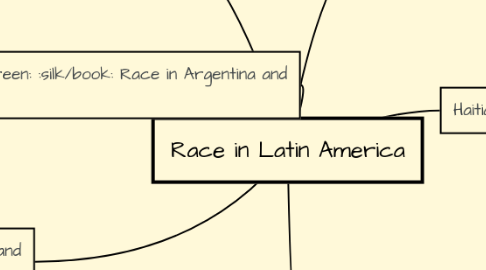Race in Latin America
par Dianna Limon

1. Race in Argentina and Cuba
1.1. Partido Independiente de Color-advocated to end to racial discrimination, priority for Cubans in employment
1.1.1. three thousand -four thousand afro-Cubans were massacred by the army
1.2. Little War-perpetual and implacable struggle between races
2. Impact of the French and Haitian Revolution
2.1. Haitia Revolution reinforced the conviction that slaves emancipation in any form would lead to economic ruin and to the indiscriminate massacre of white people
2.2. 1794 French National Concention outlawed slavery in all French colonies and granted the rights of citizenship to all men regardless of color
2.3. British and French armies failed to conquer Saint Domingue; made is easier for government leaders to restrict slaves to Trinidad and Guiana
3. Race ideas and social policy in Brazil
3.1. Whitening thesis got unique support in Brazil from the widespread belief, Portuguese enjoyed and uncanny ability to whiten the darker peoples with whom they mixed
3.2. liberal abolitionist preferred to think about European immigrants as the solution to the postabolition labor problem
3.3. abolitionist believed that miscegenation would gradually and inexorably "whiten" and thereby "upgrade" the Brazilian popultion
4. Enlightment in the Americas
4.1. enlightenment liberal thought was not clear who got to be human;
4.2. women did not share natural rights other non-Europeans were not equal to europens
4.3. American Indians, Africans, mestizos were lower class of society- elites did not grant them political rights
5. Haitian Revolution
5.1. Saint Domingue, the inability of the French government to decide whether to grant wealthy free persons of color citizenship, pushed them towards independence
5.2. 1804 slaves achieved their freedom and established the new nation of haiti
6. Racism Revolution & Indigenismo 1910
6.1. Status is subjective- an indian is one who feels that he belongs to an indigenous community
6.2. Distiction must be made between the entrinsic perception if the individual/community and the extrinsic perception of outside observers
6.3. indigenismo represented another non-Indian formulation of the indian problem; another white/mestizo contrust


